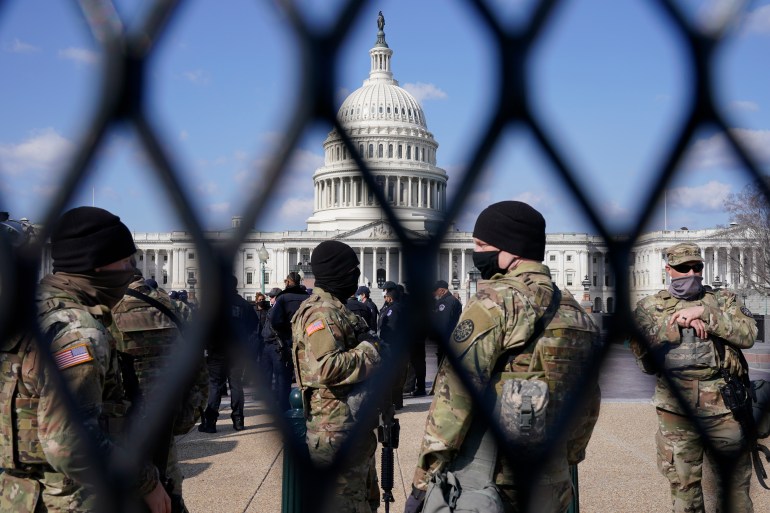US Capitol fence to be scaled back, security questions linger
Security fence around US Capitol is the cause of ire among some legislators, who say barrier reminds them of ‘warzone’.

Security officials have announced they will reduce fencing around the US Capitol and cut off the entire area to pedestrian and vehicular traffic since the January 6 riot, as a report says the Army was reluctant to assist Washington, DC authorities ahead of the deadly riot.
Timothy Blodgett, the acting House sergeant-at-arms, said on Monday in a memo to members of Congress the fencing will be scaled back in two phases in response to guidance from the US Capitol Police that “there does not exist a known, credible threat” that warrants keeping the temporary barrier in place.
Keep reading
list of 3 itemsUS Capitol security needs significant upgrade, report concludes
US charges two suspects for assault on fallen Capitol policeman
The moves will “move the fence closer to the Capitol building and will provide access to the avenues and some of the sidewalks. The [Architect of the Capitol] will also remove the razor wire on the inner perimeter fence”.
The riot, an attempt by far-right supporters of former President Donald Trump to stop a joint session of Congress from certifying President Joe Biden’s electoral victory, led to five deaths. The Justice Department has charged more than 300 people in relation to the riot and plans to charge at least 100 more.
How to protect legislators, while keeping the Capitol grounds open to visitors, has emerged as one of the more daunting questions from the deadly insurrection.
Legislators from both parties have decried the fencing as unsightly, expensive and beyond what is necessary, describing their unease at arriving for work each day in what can feel like a war zone, with checkpoints and National Guard troops lining the perimeter fence.
The absence of tourists snapping photos of the Capitol dome or constituents meeting with representatives is an emotional loss on top of coronavirus restrictions, according to The Associated Press news agency, even as security concerns remain high.
House Speaker Nancy Pelosi said in a letter to colleagues after Blodgett’s announcement that the Capitol Police “will continue to monitor the threat posture, and plans will be adjusted if and as needed”.
Initial reluctance
The calls for the barrier’s removal come as the Washington Post reveals US Army officials “pushed” to block a request from the DC government for a small contingent of National Guard troops before the Capitol riot.
The Post cited an internal draft memo, explaining it said troops “shouldn’t be needed to help police with traffic and crowd management, as city officials had requested unless more than 100,000 demonstrators were expected”.
The Post claimed the memo made clear the “reluctance” from top Pentagon officials highlighted their questions over the use of US military on domestic soil.

But “the Mayor’s request was approved and supported”, Wilkinson told the Post. “The draft memo was not signed or approved. It is customary for the Army staff to provide options for Army senior leaders to inform their decision making process.”
Political pressure to remove the security fencing has been building. The Senate Republican leader, Mitch McConnell of Kentucky, has compared it with a combat zone in Afghanistan, saying that “we are way overreacting”. The number two Senate Democrat, Dick Durbin of Illinois, called it “ghastly”.
On Monday, Missouri Senator Roy Blunt, the top Republican on the Senate Rules Committee, praised the decision to scale back the fencing. “I’d go further than that if it was up to me,” Blunt said. “I think our next problem is highly unlikely to be a carbon copy of the last problem.”
Blunt said the fencing is costing taxpayers $1.9m a week, and National Guard troops protecting the Capitol have cost more than $500m since January 6.
As Congress looks for a way forward, it is unclear if legislators will be able to agree on parameters for a bipartisan commission to study the security failures. Partisan tensions remain raw and have even worsened since Trump’s supporters laid siege to the building more than two months ago.
The idea of a 9/11-style commission has stalled since Pelosi originally proposed creating an 11-member body with four Republicans and seven Democrats, three of whom would be chosen by President Joe Biden.
Pelosi said in the letter to colleagues the commission is a “remaining priority” and the US “must get to the truth of how the January 6 assault happened, and we must ensure that it cannot happen again”.